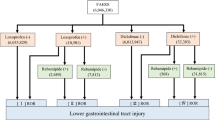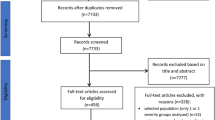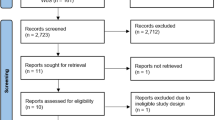Abstract
Drug toxicity in the gastrointestinal tract is a common and serious medical problem; the number of drugs that can harm the gastrointestinal tract is impressive. The morbidity, mortality, and medical costs associated with drug toxicity, even when restricted to the gastrointestinal tract, are probably underestimated. Drug-induced gastrointestinal tract pathology is very diverse and can mimic many non-drug-related conditions. Drug toxicity, whether direct or indirect, can be restricted to a segment of the gastrointestinal tract or affect the entire gastrointestinal tract. The consequences of drug toxicity are also quite variable and can range from unimportant pathology (e.g. the relatively common and usually benign drug-induced diarrhea) at one end of the spectrum, to fatal gastrointestinal tract hemorrhage or perforation at the other end of the spectrum. Better awareness of the possibility of drug-induced gastrointestinal tract pathology, by both gastroenterologists and pathologists, and better communication between gastroenterologists, pathologists and other specialists will improve the recognition of drug-induced gastrointestinal tract pathology, and, ultimately, improve patient care. This Review focuses on the most common and well-described drug-related clinicopathologic conditions of the gastrointestinal tract. Much discussion is, therefore, dedicated to NSAIDs—the most commonly prescribed drugs and consequently the drugs most commonly associated with gastrointestinal tract toxicity.
Key Points
-
Drug-induced gastrointestinal injury is common and occurs throughout the gastrointestinal tract
-
The class of drugs most commonly associated with gastrointestinal injury are the nonsteroidal anti-inflammatory drugs (NSAIDs)
-
Elimination of medications and medication avoidance in patients at highest risk for the development of drug-induced gastrointestinal injury will reduce the incidence of injury
-
Better awareness of the possibility of drug-induced gastrointestinal injury and better communication among gastroenterologists, pathologists and other specialists will ultimately improve patient care
This is a preview of subscription content, access via your institution
Access options
Subscribe to this journal
Receive 12 print issues and online access
$209.00 per year
only $17.42 per issue
Buy this article
- Purchase on Springer Link
- Instant access to full article PDF
Prices may be subject to local taxes which are calculated during checkout






Similar content being viewed by others
References
Fennerty MB (2001) NSAID-related gastrointestinal injury. Evidence-based approach to a preventable complication. Postgrad Med 110: 87–88, 91–94
Singh G (1998) Recent considerations in nonsteroidal anti-inflammatory drug gastropathy. Am J Med 105: 31S–38S
Abid S et al. (2005) Pill-induced esophageal injury: endoscopic features and clinical outcomes. Endoscopy 37: 740–744
Kikendall JW (1999) Pill esophagitis. J Clin Gastroenterol 28: 298–305
Kikendall JW (1999) Pill-induced esophageal injury. In The Esophagus, edn 3, 527–537 (Eds Castell DO and Richter JE) Philadelphia: Lippincott Williams & Wilkins
Cameron RB (1997) Esophagitis dissecans superficialis and alendronate: case report. Gastrointest Endosc 46: 562–563
Adachi W et al. (1998) A case of pill-induced esophagitis with mucosal dissection. Diagn Ther Endosc 4: 149–153
Semble EL et al. (1989) Nonsteroidal anti-inflammatory drugs and esophageal injury. Semin Arthritis Rheum 19: 99–109
Gulsen MT et al. (2005) Cyproterone acetate and ethinylestradiol-induced pill oesophagitis: a case report. Int J Clin Pract Suppl 147: 79–81
D'Agostino L et al. (2004) A life-threatening case of stenosing pill hypopharynx-oesophagitis caused by a tamsulosin capsule. Dig Liver Dis 36: 632–634
Maekawa T et al. (2001) Pill-induced esophagitis caused by lansoprazole. J Gastroenterol 36: 790–791
Abraham SC et al. (1999) Alendronate associated esophageal injury: pathologic and endoscopic features. Mod Pathol 12: 1152–1157
de Groen PC et al. (1996) Esophagitis associated with the use of alendronate. N Engl J Med 335: 1016–1021
Lufkin EG et al. (1994) Pamidronate: an unrecognized problem in gastrointestinal tolerability. Osteoporos Int 4: 320–322
Quinn CM et al. (1993) Gastritis in patients on non-steroidal anti-inflammatory drugs. Histopathology 23: 341–348
Sobala GM et al. (1990) Reflux gastritis in the intact stomach. J Clin Pathol 43: 303–306
Graham DY and Smith JL (1988) Gastroduodenal complications of chronic NSAID therapy. Am J Gastroenterol 83: 1081–1084
Schoenfeld P et al. (1999) Nonsteroidal anti-inflammatory drug-associated gastrointestinal complications—guidelines for prevention and treatment. Aliment Pharmacol Ther 13: 1273–1285
Cryer B (2001) Nonsteroidal anti-inflammatory drug gastrointestinal toxicity. Curr Opin Gastroenterol 17: 503–512
Jones R (2002) Efficacy and safety of COX 2 inhibitors. BMJ 325: 607–608
Deeks JJ et al. (2002) Efficacy, tolerability, and upper gastrointestinal safety of celecoxib for treatment of osteoarthritis and rheumatoid arthritis: systematic review of randomised controlled trials. BMJ 325: 619
Bombardier C et al. (2000) Comparison of upper gastrointestinal toxicity of rofecoxib and naproxen in patients with rheumatoid arthritis. VIGOR Study Group. N Engl J Med 343: 1520–1528
Mamdani M et al. (2002) Observational study of upper gastrointestinal haemorrhage in elderly patients given selective cyclo-oxygenase-2 inhibitors or conventional non-steroidal anti-inflammatory drugs. BMJ 325: 624
Silverstein FE et al. (1995) Misoprostol reduces serious gastrointestinal complications in patients with rheumatoid arthritis receiving nonsteroidal anti-inflammatory drugs. A randomized, double-blind, placebo-controlled trial. Ann Intern Med 123: 241–249
Chan FK et al. (2002) Celecoxib versus diclofenac and omeprazole in reducing the risk of recurrent ulcer bleeding in patients with arthritis. N Engl J Med 347: 2104–2110
Scheiman JM et al. (2006) Prevention of ulcers by esomeprazole in at-risk patients using non-selective NSAIDs and COX-2 inhibitors. Am J Gastroenterol 101: 701–710
Driman DK et al. (1996) Omeprazole produces parietal cell hypertrophy and hyperplasia in humans. Dig Dis Sci 41: 2039–2047
Rindi G et al. (2005) European Rabeprazole Study Group. Effects of 5 years of treatment with rabeprazole or omeprazole on the gastric mucosa. Eur J Gastroenterol Hepatol 17: 559–566
Choudhry U and Boyce HW Jr (1998) Proton pump inhibitor-associated gastric polyps: a retrospective analysis of their frequency, and endoscopic, histologic, and ultrastructural characteristics. Am J Clin Pathol 110: 615–621
Sapoznikov B et al. (2005) Minidose aspirin and gastrointestinal bleeding—a retrospective, case–control study in hospitalized patients. Dig Dis Sci 50: 1621–1624
Cryer B et al. (1995) Effects of very low doses of aspirin on gastric, duodenal and rectal prostaglandins and mucosal injury. Gastroenterology 108: A77
Reuter BK et al. (1997) Nonsteroidal anti-inflammatory drug enteropathy in rats: role of permeability, bacteria, and enterohepatic circulation. Gastroenterology 112: 109–117
Somasundaram S et al. (2000) Uncoupling of intestinal mitochondrial oxidative phosphorylation and inhibition of cyclooxygenase are required for the development of NSAID-enteropathy in the rat. Aliment Pharmacol Ther 14: 639–650
Bjarnason I et al. (1984) Intestinal permeability and inflammation in rheumatoid arthritis: effects of non-steroidal anti-inflammatory drugs. Lancet 2: 1171–1174
Bjarnason I et al. (1987) Blood and protein loss via small-intestinal inflammation induced by non-steroidal anti-inflammatory drugs. Lancet 2: 711–714
Bjarnason I et al. (1987) Nonsteroidal antiinflammatory drug-induced intestinal inflammation in humans. Gastroenterology 93: 480–489
Morris AJ et al. (1992) Small bowel enteroscopy in undiagnosed gastrointestinal blood loss. Gut 33: 887–889
Kepczyk T and Kadakia SC (1995) Prospective evaluation of gastrointestinal tract in patients with iron-deficiency anemia. Dig Dis Sci 40: 1283–1289
Lee FD (1994) Drug related pathological lesions of the intestinal tract. Histopathology 24: 303–308
Thiéfin G et al. (2000) Diaphragme duodénal induit par la prise d'aspirine [French]. Presse Med 29: 1351–1352
Cortina G et al. (1999) Clinical and pathologic overlap in nonsteroidal anti-inflammatory drug-related small bowel diaphragm disease and the neuromuscular and vascular hamartoma of the small bowel. Am J Surg Pathol 23: 1414–1417
Isaacs PE et al. (1987) Mefenamic acid enteropathy. J Clin Pathol 40: 1221–1227
Freeman HJ (1986) Sulindac-associated small bowel lesion. J Clin Gastroenterol 8: 569–571
Gibson GR et al. (1992) Colitis induced by nonsteroidal anti-inflammatory drugs. Report of four cases and review of the literature. Arch Intern Med 152: 625–632
Kaufman JH and Taubin HL (1987) NSAID activate quiescent inflammatory bowel disease. Ann Intern Med 107: 513–516
Stamm C et al. (1994) Benign colonic ulcers associated with nonsteroidal antiinflammatory drug ingestion. Am J Gastroenterol 89: 2230–2233
Halter F et al. (1993) Diaphragm disease of the ascending colon. Association with sustained-release diclofenac. J Clin Gastroenterol 16: 74–80
Bridges AJ et al. (1990) Acute eosinophilic colitis and hypersensitivity reaction associated with naproxen therapy. Am J Med 89: 526–527
Hall RI et al. (1983) Enteritis and colitis associated with mefenamic acid. BMJ 287: 1182
Beaugerie L et al. (1994) Drug induced lymphocytic colitis. Gut 35: 426–428
Giardiello FM et al. (1990) Collagenous colitis in setting of nonsteroidal anti-inflammatory drugs and antibiotics. Dig Dis Sci 35: 257–260
Campbell KL and de Baux AC (1992) Non-steroidal anti-inflammatory drugs and appendicitis in patients over 50 years. Br J Surg 79: 967–968
Wilson RG et al. (1990) Complications of diverticular disease & non-steroidal anti-inflammatory drugs: a prospective study. Br J Surg 77: 1103–1104
D'Halluin PN et al. (2003) Selective COX-2 inhibitor-associated colitis: two case reports. Gastroenterol Clin Biol 27: 932–935
Ghadially FN and Walley VM (1994) Melanoses of the gastrointestinal tract. Histopathology 25: 197–207
Byers RJ et al. (1997) Melanosis coli is associated with an increase in colonic epithelial apoptosis and not with laxative use. Histopathology 30: 160–164
Biggar WD et al. (1985) Malakoplakia and immunosuppressive therapy: Reversal of clinical and leukocyte abnormalities after withdrawal of prednisone and azathioprine. Am J Pathol 119: 5–11
Guinaudeau E et al. (2002) Colonic malacoplakia and ulcerative colitis: report of a case. Gastroenterol Clin Biol 26: 174–177
Jackson CW et al. (1986) Gold induced enterocolitis. Gut 27: 452–456
Thomson RD et al. (2002) Lansoprazole-associated microscopic colitis: a case series. Am J Gastroenterol 97: 2908–2913
Beaugerie L et al. (1995) Ranitidine, diarrhoea, and lymphocytic colitis. Gut 37: 708–711
Feurle GE et al. (1999) Lymphocytic colitis, induced by ticlopidine. Z Gastroenterol 37: 1105–1108
Fernandez-Banares F et al. (2003) Collagenous and lymphocytic colitis: evaluation of clinical and histological features, response to treatment, and long-term follow-up. Am J Gastroenterol 98: 340–347
Cappell MS (2004) Colonic toxicity of administered drugs and chemicals. Am J Gastroenterol 99: 1175–1190
Freudenberger RS et al. (1990) Intestinal infarction after intravenous cocaine administration. Ann Intern Med 113: 715–716
Linder JD et al. (2000) Cocaine-associated ischemic colitis. South Med J 93: 909–913
Stillman AE et al. (1977) Ischemic bowel disease attributable to ergot. Gastroenterology 72: 1336–1337
McClennan BL (1976) Ischemic colitis secondary to premarin: report of a case. Dis Colon Rectum 19: 618–620
Friedel D et al. (2001) Ischemic colitis during treatment with alosetron. Gastroenterology 120: 557–560
Beyer KL et al. (1991) Ischemic colitis associated with dextroamphetamine use. J Clin Gastroenterol 13: 198–201
Rashid A and Hamilton SR (1997) Necrosis of the gastrointestinal tract in uremic patients as a result of sodium polystyrene sulfonate (Kayexalate) in sorbitol: an underrecognized condition. Am J Surg Pathol 21: 60–69
Kato S et al. (1995) Antibiotic-associated hemorrhagic colitis without Clostridium difficile toxin in children. J Pediatr 126: 1008–1010
Kronawitter U et al. (1997) Neutropenic enterocolitis in a patient with colorectal carcinoma: unusual course after treatment with 5-fluorouracil and leucovorin—a case report. Cancer 80: 656–660
Petruzelli GJ et al. (1990) Neutropenic enterocolitis: a new complication of head and neck cancer chemotherapy. Arch Otolaryngol Head Neck Surg 116: 209–211
Eckardt VF et al. (1986) Anorectal ergotism: another cause of solitary rectal ulcers. Gastroenterology 91: 1123–1127
Gizzi G et al. (1990) Ano-rectal lesions in patients taking suppositories containing non-steroidal anti-inflammatory drugs (NSAID). Endoscopy 22: 146–148
Van Gossum A et al. (1993) Anorectal stenosis in patients with prolonged use of suppositories containing paracetamol and acetylsalicylic acid. Dig Dis Sci 38: 1970–1977
de Parades V et al. (1996) Complications anorectales et coliques des suppositoires et des lavements [French]. Gastroenterol Clin Biol 20: 446–452
Eckstein RP and Symons P (1996) Iron tablets cause histopathologically distinctive lesions in mucosal biopsies of the stomach and oesophagus. Pathology 28: 142–145
Hruban RH et al. (1989) Taxol toxicity: epithelial necrosis in the gastrointestinal tract associated with polymerized microtubule accumulation and mitotic arrest. Cancer 15: 1944–1950
Finger JE and Headington JT (1963) Colchicine-induced epithelial atypia. Am J Clin Pathol 40: 605–609
Iacobuzio-Donahue CA et al. (2001) Colchicine toxicity: distinct morphologic findings in gastrointestinal biopsies. Am J Surg Pathol 25: 1067–1073
Gibson RJ et al. (2003) Irinotecan causes severe small intestinal damage, as well as colonic damage, in the rat with implanted breast cancer. J Gastroenterol Hepatol 18: 1095–1100
Sandmeier D et al. (2005) Irinotecan-induced colitis. Int J Surg Pathol 13: 215–218
Sears S et al. (1999) Irinotecan (CPT-11) induced colitis: report of a case and review of Food and Drug Administration MEDWATCH reporting. Gastrointest Endosc 50: 841–844
Author information
Authors and Affiliations
Corresponding author
Ethics declarations
Competing interests
The authors declare no competing financial interests.
Rights and permissions
About this article
Cite this article
Pusztaszeri, M., Genta, R. & Cryer, B. Drug-induced injury in the gastrointestinal tract: clinical and pathologic considerations. Nat Rev Gastroenterol Hepatol 4, 442–453 (2007). https://doi.org/10.1038/ncpgasthep0896
Received:
Accepted:
Issue Date:
DOI: https://doi.org/10.1038/ncpgasthep0896
This article is cited by
-
Zinc and L-carnitine combination with or without methotrexate prevents intestinal toxicity during arthritis treatment via Nrf2/Sirt1/Foxo3 pathways: an In vivo and molecular docking approach
Inflammopharmacology (2023)
-
Lactiplantibacillus plantarum Strain FLPL05 Promotes Longevity in Mice by Improving Intestinal Barrier
Probiotics and Antimicrobial Proteins (2023)
-
The interplay between anticancer challenges and the microbial communities from the gut
European Journal of Clinical Microbiology & Infectious Diseases (2022)
-
A peptidoglycan storm caused by β-lactam antibiotic’s action on host microbiota drives Candida albicans infection
Nature Communications (2021)



